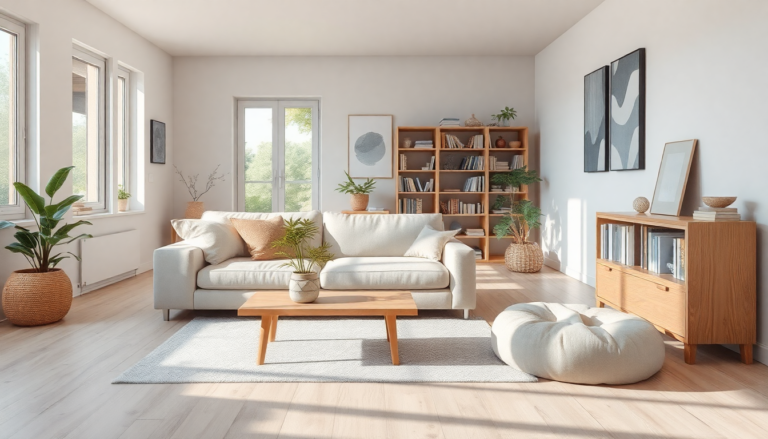Argomenti trattati
Imagine stepping into your home and feeling an immediate wave of calm wash over you. Sounds dreamy, right? Achieving this blissful state, often referred to as “room serenity,” isn’t just about the way your space looks—it’s about how it makes you feel. Designers and therapists alike agree that the right environment can foster relaxation and safety, inviting you to unwind after a long day. So, how can you curate your space to create that perfect haven of tranquility? Let’s dive into some transformative design ideas.
Understanding the power of design
To start, let’s think about what makes a space feel serene. Interior designer Rachel Blindauer emphasizes the importance of creating a space that feels like a sanctuary. She often asks her clients, “Where do you want the eye to rest? Where do you want the heart to land?” These questions lay the groundwork for a design that promotes comfort and vulnerability. It’s about balancing softness with containment—think muted colors, natural materials, and a touch of asymmetry to break the monotony.
Consider how therapeutic spaces are crafted. Designers working with therapists often incorporate findings from neuroscience to create environments that put clients at ease. By integrating soft textures and grounding elements, they help diminish the rigidities of a clinical atmosphere. It’s an art, really. The goal is to evoke feelings of safety and calmness, making it easier to be vulnerable and open up, whether in a therapy session or at home.
Incorporating nature for tranquility
One surefire way to enhance serenity is by embracing biophilic design—bringing nature indoors. This approach utilizes elements like live plants, natural light, and even water features to create a soothing environment. Imagine the gentle rustle of leaves or the sound of a small fountain; it’s like nature’s lullaby. Anita Yokota, a therapist-turned-interior designer, advises using materials like wood and stone to foster a sense of grounding and stability. They connect us to our primal roots and invite a certain calmness into our lives.
But it’s not just about having houseplants. You can tap into nature-inspired patterns in your furnishings, like rugs or wall art that reflect the beauty of the outdoors. Erica McLain, a Science in Design-certified designer, points out that our brains are naturally drawn to fractals—those repeating patterns found in nature—which can be incredibly soothing to our senses. It’s fascinating, isn’t it?
The right colors for calming vibes
When it comes to colors, think earth tones. Avoid anything too bright or saturated, as vibrant hues can feel overstimulating. Yokota recommends shades like blush, lavender, and sage green, particularly those with gray undertones to soften their intensity. These colors invite a quiet, soothing energy into the space.
However, don’t shy away from adding some warmth to your palette. Licensed psychologist Hannah Holmes shares her experience designing her therapy office, balancing cool tones with warm accents to keep the space feeling alive yet serene. It’s all about creating a space that inspires peace while also being invigorating.
Layering light for a calming atmosphere
Lighting is another crucial element in achieving room serenity. Harsh overhead lights can often create a tense environment. Instead, consider layering your lighting with warm, dimmable sources. Eryn Oruncak, a designer certified in Science In Design, suggests incorporating beautiful lamps with warm bulbs and maximizing natural light whenever possible. This layered approach creates gentle contrasts between light and shadow, which can help the brain feel cocooned and relaxed.
Did you know that the right lighting can even lower cortisol levels? It’s true! Soft, indirect lighting encourages your body to shift from a state of stress to one of relaxation. For optimal results, look for bulbs with a color temperature of 3000K or lower—your future self will thank you.
Choosing the right furniture
Now, let’s talk about furniture. You might think of those classic chaise lounges from therapy rooms, but there’s a world of options to consider. Look for pieces with soft lines and rounded silhouettes; as Yokota puts it, “no sharp edges, no emotional armor.” The arrangement of your seating is just as important as the pieces themselves. Aim for setups that foster equality and intimacy, like slightly angled seating, to soften any power dynamics.
Holmes focuses on positioning her furniture to ensure that both she and her clients have easy access to the door and a view outside—this subtle touch can make a world of difference for someone with a history of trauma. It’s those little details that often matter the most.
Creating a tactile experience
Textures play a crucial role in crafting a serene environment. Think of soft, inviting materials like bouclé, washed linen, or matte clay. These textures can create what Blindauer calls a “tactile lullaby.” It’s not just about pillows and throws; the same principle applies to upholstery and flooring. Rich fabrics underfoot and soft rugs invite comfort and emotional safety.
Indeed, the beauty of creating a serene room lies in the details. You don’t need a complete overhaul to invite a sense of ease into your life. Sometimes, it’s as simple as a cozy chair or a pillow that feels just right. McLain reminds us that even small details can signal safety and comfort.
Avoiding the sterile feel
Finally, steer clear of anything that feels too formal or clinical. You want your home to feel lived-in and warm, not cold and sterile. Walker cautions against glossy surfaces and rigid furniture—these can create an atmosphere reminiscent of a hospital rather than a home. Opt for pieces that feel inviting and personal.
Ultimately, achieving room serenity is about finding what resonates with you. The journey to a peaceful home doesn’t have to be overwhelming. Embrace the little things that make you feel safe and comfortable, and let your space reflect that. After all, your home should be your sanctuary—a place where you can truly exhale and be yourself.

